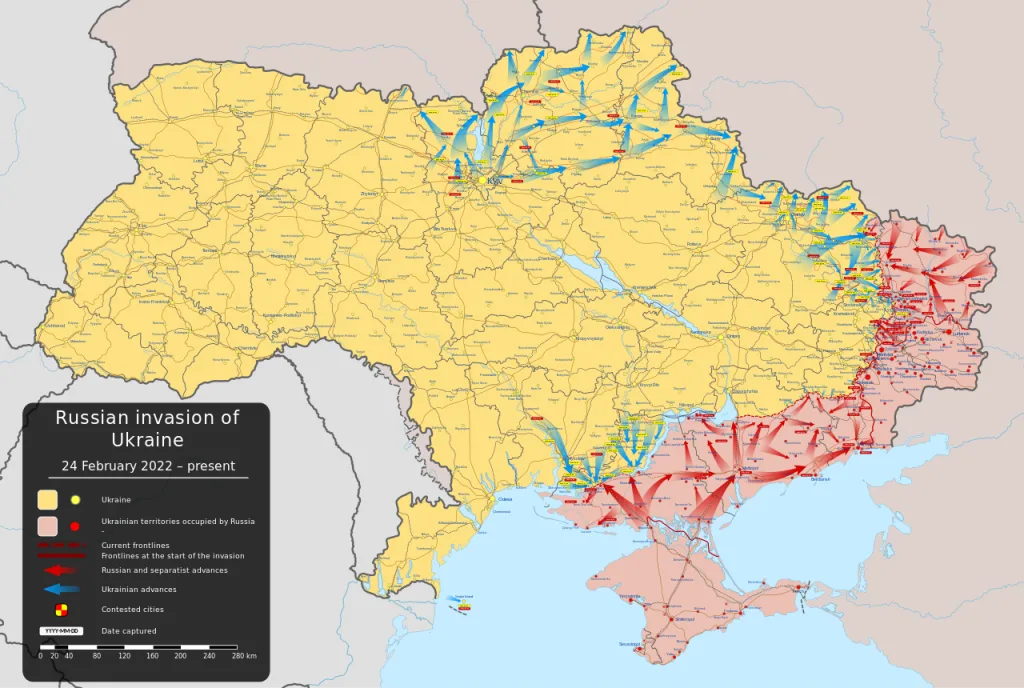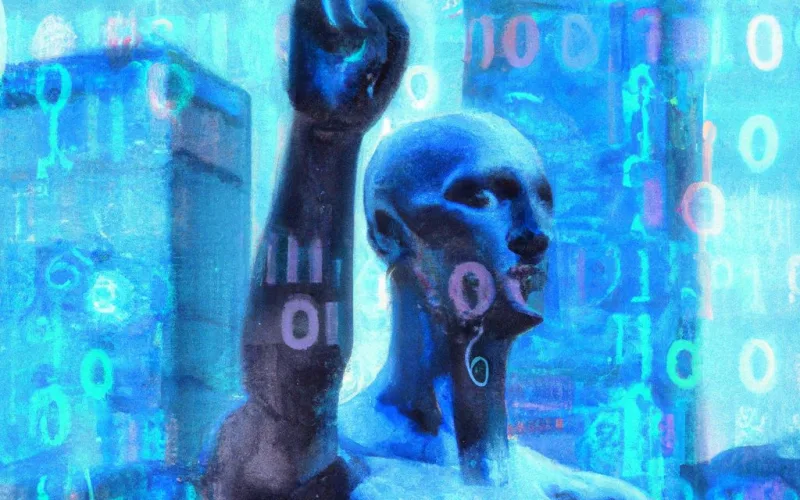Last Updated on November 8, 2023 by Ecologica Life
The rise of Artificial Intelligence (AI) in recent years has been the subject of conversation for many news stories, blog posts, YouTuber videos and podcasts. We recently discussed how AI might impact the environment.
Many have wondered how AI will affect our lives, with possibilities ranging from us laying on a sunny beach somewhere being free from work to some form of Armageddon.
What has always been true of humans and technology throughout the millennia is that, some of us will use it for good and others for harm. I suspect that the impact of AI on our lives will depend on the percentage of us who use AI for good and those who use it for evil. So let’s be a part of the group that uses AI for good.
With this in mind, I then decided to ask AI to solve one of the most important issues to date; how to achieve peace in the conflict between Ukraine and Russia.
Table of Contents
Background: The War in Ukraine
As many of you know, the war in Ukraine began in February 2022. In Russia it is known as a ‘special military operation’. Analysts claim that the Russian military wanted a swift victory, and aimed to take Kyiv in a matter of days or weeks. While this may have been Putin’s plan to begin with, it has now become a war that has lasted well over a year. It has brought nothing but death and destruction to the region, displacing millions, and destroying the local environment.
A year and a half later, the idea of peace does not seem to be openly discussed. The Russian forces have captured many regions in eastern Ukraine and have managed to create a land corridor from Russia to Crimea, which was annexed by Russia in February 2014.

If you want to know more about the current situation of the war in Ukraine, you can watch this video where three experts discuss the current Ukrainian counter-offensive. The experts consist of two analysts from Moscow and the UK as well as a former NATO member.
ChatGPT, Help Us.
Since I could not foresee a road to peace based on the current state of affairs. I decided to employ AI to do the job. Specifically, ChatGPT4.

For those of you who have been living under a rock, ChatGPT4 is the latest Chat Transformer model that is available to the public. It is a text prediction algorithm that predicts the next letter, word or phrase based on some very complex statistical analysis and neural networks. I don’t claim to understand it and neither do those working on the latest ChatGPT model either. But that is a story for another time.
I wanted to see if we could use ChatGPT to imagine a peace agreement between Russia and Ukraine. I started by testing ChatGPT4’s knowledge of current events:
Me: “Is there a war happening between Russia and Ukraine?“
GPT4: “As an AI, I don’t have the ability to provide real-time information or updates. My training only includes knowledge up until September 2021. For current information on global events such as a potential conflict between Russia and Ukraine, please refer to the latest news reports from reliable sources.“
As you can see, the GPT4’s limitations are that it only has information up to 2021. So I asked it the following:
Me: “Imagine there was a war happening between Russia and Ukraine. Russia has invaded Ukraine and taken the Eastern Ukrainian regions and has been able to make a ‘corridor’ to Crimea which was annexed by Russia in 2014. What do you think would be useful way for Western nations to help negotiate a peace between Russia and Ukraine?“
And it answered the following:
GPT4:
“In a hypothetical scenario of armed conflict, there are several diplomatic tools that Western nations could potentially use to mediate peace between Russia and Ukraine:
- Direct Diplomacy: Direct diplomacy involves engaging with both parties in talks, either through multilateral or bilateral dialogue. It would require a neutral or trusted party to facilitate negotiations, which could involve brokering a ceasefire, and discussing terms for peace, territorial disputes, and possible reparations.
- Sanctions: Sanctions could be imposed to pressure Russia into ending the conflict. These sanctions could target economic sectors, individuals involved in the conflict, or even state institutions. However, the effectiveness of sanctions varies and could potentially harm ordinary citizens more than the government.
- Support to Ukraine: Providing non-lethal aid such as intelligence, training, humanitarian aid, and financial support to Ukraine can help them manage and potentially resolve the conflict. However, it’s crucial that any support given does not escalate the conflict further.
- Engaging International Organizations: The UN, EU, and NATO could be engaged to mediate the conflict. The United Nations Security Council could be called upon to pass resolutions condemning the invasion, and the International Court of Justice could potentially be involved regarding any breaches of international law.
- Involvement of other influential countries: Involving countries that have significant influence over Russia (like China or India) might contribute to the peace process. They could play a crucial role in encouraging Russia to de-escalate the conflict.
- Public Diplomacy: Using public diplomacy tools like the media, cultural exchanges, and public statements to shape public opinion against the conflict and generate more support for peace initiatives.
- Long-term Commitment: Any negotiation for peace would likely need a longer-term commitment to rebuilding and reconciliation efforts. This could involve ensuring human rights are respected, addressing any war crimes, and helping to rebuild infrastructure and communities.
These strategies can be complex and interlinked. However, it’s important to remember that peace negotiations often take time and may require compromises from both parties. It would also be necessary to address underlying issues that led to the conflict, such as political and socio-economic factors, to prevent similar conflicts in the future.”
What is so fascinating about this answer, is that without any knowledge of events after 2021, the model has outlined real world events that have taken place since the start of war in Ukraine. Lets analyse them in more detail.
2. Sanctions
Skipping over diplomacy as that is a given in any conflict. Western nations did impose sanctions on Russia when the war began. And ChatGPT’s final statement in this paragraph is correct. We haven’t seen these sanctions affect Russia gravely in any way and it is plausible that they have harmed ordinary citizens far more than the Russian government.
It is important to note that Russia was stockpiling gold before the war and continues to do so. Likely to preserve their economy after the sanctions happened. They have also been able to continue trading with eastern nations such as China and India.
3. Support to Ukraine
Every word of this statement is so relevant to the current conflict that it is hard to imagine ChatGPT wrote it. Let’s break it down.
First of all, lets examine the words “non-lethal aid”. Because at the beginning of this conflict, that’s what most of the aid to Ukraine was, non-lethal. It was mainly focused on intelligence, training, humanitarian aid, and financial support to Ukraine.
A year and a half into the conflict, the picture has changed dramatically. Countries that did not provide arms before such as Germany are now doing so. Countries such as the UK and United States, which previously provided less lethal aid, are now providing more technologically advanced military aid, such as long range missles and perhaps even fighter jets.
This is important because at chatgpt says, it is crucial that we do not escalate this conflict any further. So it begs the question, should we be providing lethal aid in this conflict? Are we sure this is a good strategy to de-escalate this war? These are very important questions to consider especially when we are talking about a state with nuclear weapons.
ChatGPT, with it’s 2021 knowledge cap also correctly predicted the involvement of the International Court of Justice, as well as the involvement of China in this conflict. The International Court of Justice has issued a warrent for Putin’s arrest. While the Chinese government wants to broker a peace between Russia and Ukraine, there have been some interesting suggestions as to why the Chinese government wants to do this.
What we haven’t seen yet in this conflict is public diplomacy or long-term commitments made from either side. Perhaps these are the next steps in this conflict that GPT4 also foresaw. If so, that would be good news for everyone.
It is in everyone’s interest to push for peace in this conflict, and Western nations, should help broker a peace between the two nations that were once one in the Soviet Union. Indeed, many still have family ties across these two borders. Maybe it’s time start arming de-escalation.
What Will a Russian-Ukrainian Peace Look Like?
Finally, I wanted to ask ChatGPT what a peace agreement between Russia and Ukraine would look like. Given that Putin will not want to give up any of the land captured, and Zelensky wants the whole of Ukraine back, including Crimea. A peace agreement will be difficult to negotiate.
Me: “In this hypothetical situation. What would a peace agreement look like between Russia and Ukraine, given that Russia will not want to give up land captured and Ukraine will want all of its land reclaimed.“
GPT4:
“A peace agreement in such a situation could be extremely challenging to negotiate, given the seemingly irreconcilable positions of the two parties. However, history shows that even in the most intractable conflicts, solutions can sometimes be found. Here are a few possibilities that might be considered, each with its own potential advantages and drawbacks:
- Status Quo Ante: This would involve Russia withdrawing from all Ukrainian territory captured during the conflict, including the “corridor” to Crimea and Crimea itself, thereby restoring the situation to the status it held prior to the 2014 annexation. Russia is unlikely to accept such terms without significant concessions from Ukraine and international guarantees.
- Land Swap: A land swap might be one potential compromise. This would involve an exchange of territories between the two countries, allowing both to claim some form of victory. However, this would likely be very controversial, and residents of the swapped territories might strongly resist such an arrangement.
- Autonomy or Federation: Ukraine might grant the disputed territories a special status, such as wide-ranging autonomy or a federal arrangement within Ukraine. This could potentially satisfy Russian concerns for the rights of Russian-speaking populations in these areas, while preserving Ukraine’s territorial integrity. However, this could also lead to long-term instability if not handled correctly.
- Independent or Semi-Independent Entities: The disputed territories could be set up as independent or semi-independent entities, with their security and rights guaranteed by international agreements. Such a solution would likely require a strong and lengthy international peacekeeping and administrative presence, and the details of sovereignty could be difficult to negotiate.
- International Administration: An international body or consortium could take temporary control of the disputed territories, with the goal of administering them impartially and eventually holding a referendum to determine their future status. This could be a way to deescalate the conflict and provide a path towards a peaceful resolution.
Each of these options would come with significant challenges and potential drawbacks. They would likely require substantial international involvement and oversight, along with guarantees to protect the rights of local populations, potential compensation for damages, and measures to ensure long-term stability and security in the region.“
As ChatGPT rightly says, each of these situations has its challenges and drawbacks. If you ask me, options 1 and 5 are the least likely scenarios. I could see a peace agreement involving scenarios 2-4 or a mixture of them. But I will leave it to you and ultimately to the international actors to decide.
The goal should be peace. Time will tell how this conflict will inevitably end. While the outcome is still unclear, we at Ecologica.life wanted to start a discussion about what a peace between these neighbouring nations might look like. It is a discussion we should be having.







